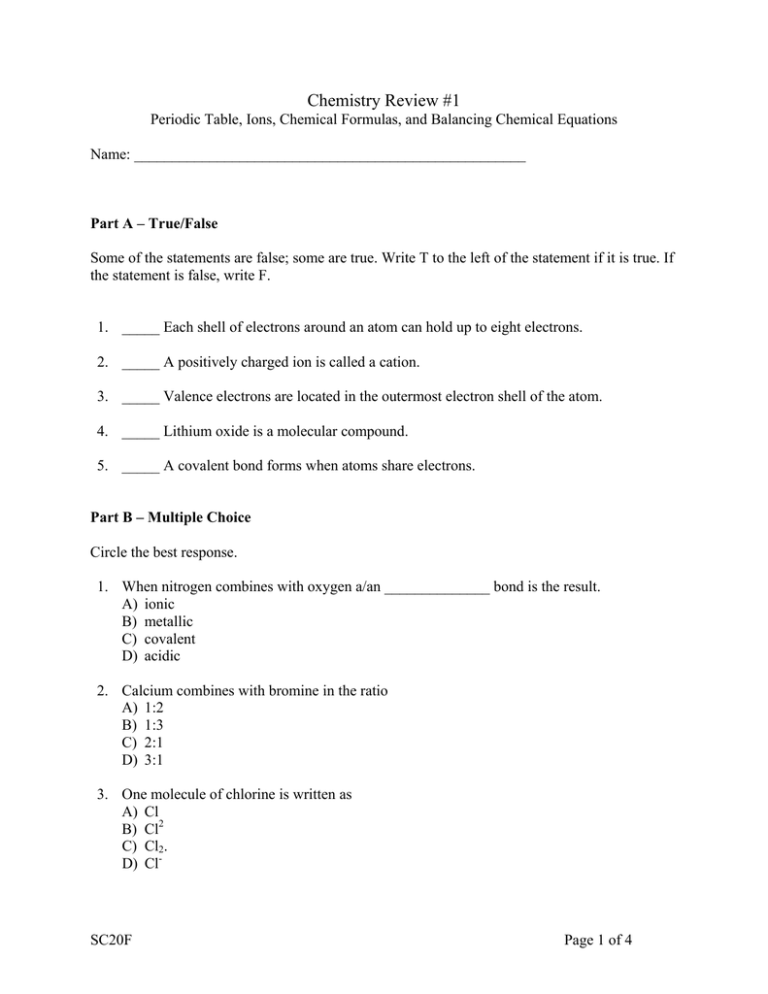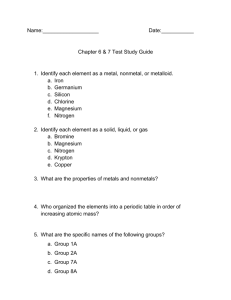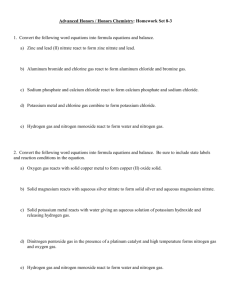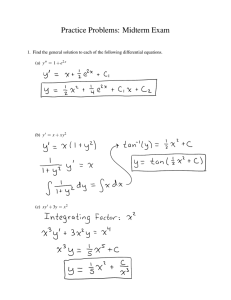Chemistry Review #1
advertisement

Chemistry Review #1 Periodic Table, Ions, Chemical Formulas, and Balancing Chemical Equations Name: ____________________________________________________ Part A – True/False Some of the statements are false; some are true. Write T to the left of the statement if it is true. If the statement is false, write F. 1. _____ Each shell of electrons around an atom can hold up to eight electrons. 2. _____ A positively charged ion is called a cation. 3. _____ Valence electrons are located in the outermost electron shell of the atom. 4. _____ Lithium oxide is a molecular compound. 5. _____ A covalent bond forms when atoms share electrons. Part B – Multiple Choice Circle the best response. 1. When nitrogen combines with oxygen a/an ______________ bond is the result. A) ionic B) metallic C) covalent D) acidic 2. Calcium combines with bromine in the ratio A) 1:2 B) 1:3 C) 2:1 D) 3:1 3. One molecule of chlorine is written as A) Cl B) Cl2 C) Cl2. D) Cl- SC20F Page 1 of 4 Part C – Fill in the Blanks Fill in the blank with the appropriate term. 1. In a chemical equation, the abbreviation “aq” stands for _______________________. 2. In a chemical equation, the abbreviation “g” stands for ________________________. Part D – Extended Answers Answer the following questions in the spaces provided. Answers are worth the points indicated. 1. Draw electron dot diagrams for each of the following elements or ions. a) Li b) Cl- 2. Write the chemical formulas of the following compounds. a) magnesium iodide _______________________________ b) aluminum oxide _________________________________ c) nitrogen dioxide _________________________________ d) silicon tetrachloride _______________________________ e) copper(II) sulfide _________________________________ f) iron(IV) oxide ____________________________________ SC20F Page 2 of 4 3. Write the chemical names of the following binary compounds. Some of the names may require use of the Stock system. a) MgI2 ___________________________________ b) LiCl _____________________________________ c) Be3N2 ___________________________________ d) CH4 ______________________________________ e) N2O4 ______________________________________ f) CuCl2 ______________________________________ g) FeO ________________________________________ 4. Balance the following chemical equations. Br2 → KBr a) K+ b) SiO2 + c) Al2(SO4)3 + d) Au2S3 + H2 → e) Na2O2 + H2O → HF → SiF4 + Ca(OH)2 → Au + H2O Al(OH)3 + CaSO4 H2S NaOH + O2 5. Write a balanced chemical equation using symbols for each of the word equations. a) SC20F Iron metal and chlorine gas react to form iron(III) chloride. Page 3 of 4 b) Hydrogen peroxide breaks down into water and oxygen. c) Methane reacts with oxygen to produce carbon dioxide and water vapor. d) Hydrogen gas and nitrogen monoxide react to form water and nitrogen gas. e) SC20F Aluminum bromide and chlorine gas react to form aluminum chloride and bromine gas. Page 4 of 4




